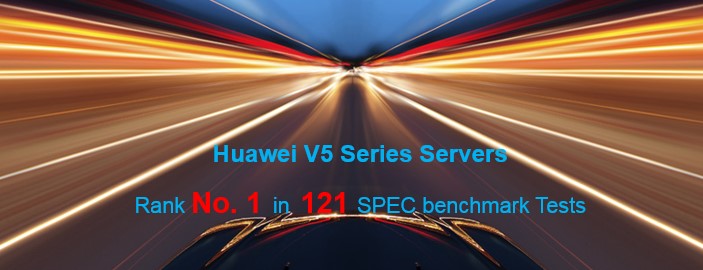
The Secret Behind Huawei’s Top Rank in 121 SPEC Benchmarks

As of September 7, 2018, Huawei V5 series servers have topped a total of 121 SPEC benchmark tests. Powered by Intel® Xeon® Scalable processors, Huawei servers are recognized in the industry for their performance, quality, and power efficiency. As published on the SPEC official website, the winning results of these 121 SPEC benchmark tests endorse the competitiveness of Huawei servers.

The test results of SPEC, an authoritative third-party comprehensive evaluation institute in the industry, have been an important reference for enterprise customers to select servers. Huawei servers top 121 SPEC tests that cover a wide spectrum of SPEC tests, including SPECint®_base2006, SPECfp®_base2006, SPECfp®_rate_base2006, SPECint®_base2017, SPECfp®_base2017, SPECint®_rate_base2017, SPECfp®_rate_base2017, and SPECpower-ssj2008. These tests focus on some of the most important indicators for measuring server performance and energy consumption, including integer computing performance, floating-point computing performance, and performance per watt.

- Integer Computing Performance
Nine Huawei server models, including FusionServer 2288H V5/1288H V5/CH121 V5/5288 V5/CH242 V5/XH321 V5/2488 V5/2488H V5/5885H V5, ranked No.1 in 58 performance tests of SPECint®_base2006, SPECint®_base2017, and SPECint®_rate_base2017.
- Floating-Point Computing Performance
Eight Huawei server models, including FusionServer 2288H V5/1288H V5/CH121 V5/5288 V5/CH242 V5/2488H V5/5885H V5/KunLun 9008 V5, ranked No.1 in 62 performance tests of SPECfp®_rate_base2006, SPECfp®_base2017, and SPECfp®_rate_base2017.
- Performance per Watt
Huawei FusionServer 2288H V5 ranked No.1 in the energy efficiency test of SPECpower-ssj2008.
Server performance and energy consumption depend on complex factors. The following uncovers Huawei servers’ secrets of winning 121 SPEC benchmark tests.
- Temperature Largely Affects Processor Performance, and Heat Dissipation Holds the Key
Huawei servers adopt an efficient end-to-end (E2E) heat dissipation design that extends from air intake vents to air exhaust vents. Aided by multiple temperature sensors, the servers can adjust fan module speeds in real time according to ambient temperatures. Huawei servers boast a string of unique designs, such as cellular air intake vents with a porosity rate of 75%, counter-rotating fan modules that improve the wind speed by 30%, 3D VC heat sinks that feature integrated pouring technique and improve heat dissipation efficiency by 3%, flow-dividing air ducts that improve heat dissipation efficiency by 9%, and independent air channels designed for I/O modules.
- High-Quality Signal Links Ensure Smooth Signal Transmission
Huawei servers are designed by three dimensions. Components are deployed in the X, Y, and Z spaces, utilizing physical space to the full and reducing interference between signal links. In terms of simulation, optimization, and processing techniques, Huawei performs three-dimensional full-sized modeling and simulation tests and optimizations on BGA ball vias, capacitors, and connectors to control signal fluctuation in a proper range and improve the impedance consistency of links. Huawei has also introduced the signal digital eye pattern detection technology into the server production. This technology can quickly identify boards with poor link signal quality, which is difficult to detect by common methods.
- In-Depth Hardware/Software Optimization from Chips to BIOS
Huawei-developed BMC chips and BIOS source code can be integrated with hardware for in-depth optimization. For example, to maximize memory performance, parameters like SNC (Sub NUMA Clustering), IMC (Integrated Memory Controller) Interleaving, and XPT (Xtended Prediction Table) Prefetch can be adjusted to improve memory bandwidth. Similar in-depth optimization can also be performed on processors and hard drives to achieve optimal performance.
- Dynamic Energy Management Technology for Energy Saving
Huawei’s patented Dynamic Energy Management Technology (DEMT) is the key to intelligent power consumption management. According to processor load and ambient temperatures, the technology intelligently and dynamically adjusts processor, memory, hard drive power consumption and fan module speeds using functions such as frequency modulation and hibernation, multiple-input multiple-output (MIMO) speed adjustment, proportional-integral-derivative (PID), and Deep Sleeping Technology (DTS 2.0). This cutting-edge technology reduces server power consumption without compromising performance.

Huawei V5 series servers include various product models, including FusionServer 2- to 4-socket rack servers, high-density servers, blade servers, and KunLun mission critical servers. In pursuit of efficiency and agility, these servers are positioned for future-oriented complex service workloads, such as cloud computing, big data, and artificial intelligence. In response to customers’ core requirements amid digital and intelligent transformation, in-depth innovations have been made on servers from structural design to production and manufacturing, and from underlying hardware to upper-layer management software. All these help Huawei servers win the first place of 121 SPEC benchmark tests. In addition to strong performance, Huawei V5 servers boast five intelligent management features: intelligent software management, intelligent automatic deployment, intelligent fault prediction and diagnosis, intelligent power consumption management, and unified asset management. These features help reduce the OPEX for large-scale deployment by 5–15%, making Huawei a preferred IT infrastructure partner for enterprise customers to implement digital and intelligent transformation.

▲ Huawei V5 server family
The post The Secret Behind Huawei’s Top Rank in 121 SPEC Benchmarks appeared first on Huawei Enterprise Blog.
Source: Huawei Enterprise Blog
—